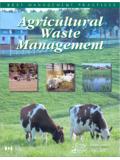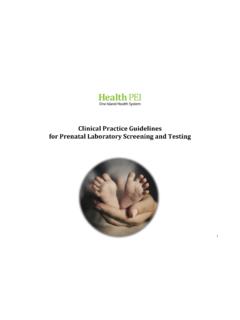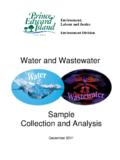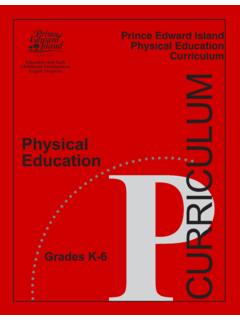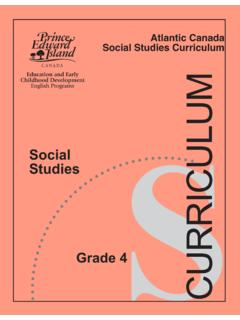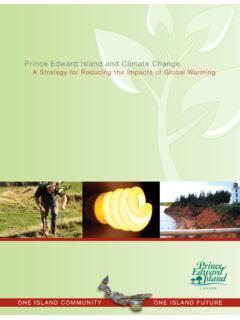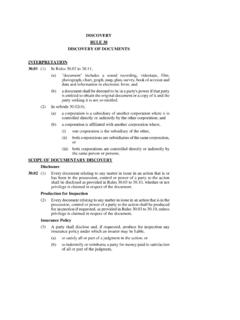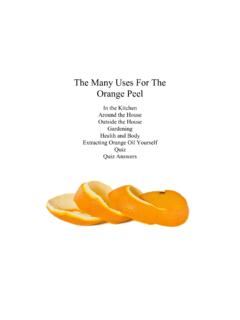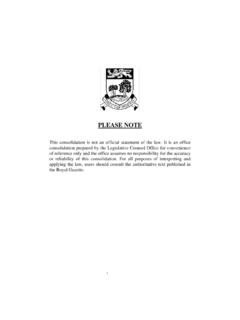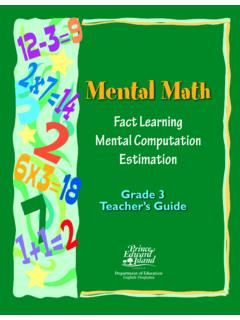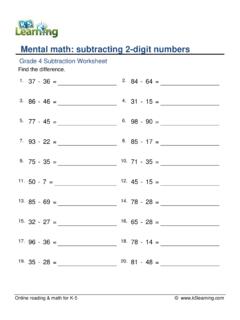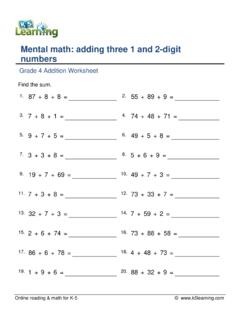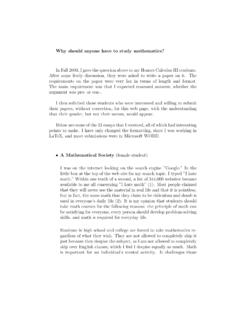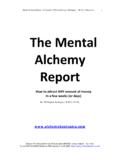Transcription of Mental Math - Prince Edward Island
1 Mental MathFact LearningMental ComputationEstimationGrade 2 Teacher s Guideb =m ~ ml=_ =OMMM` ~ I=mb===`N^=TkUq W=EVMOF=PSU=QSMMc~ W=EVMOF=PSU=QSOO K K K ~L 2008 Table of ContentsMental math in the Elementary Mathematics Curriculum ..1 Definitions and Connections ..6 Rationale ..7 Introducing Thinking Strategies to Students ..8 Practice and Reinforcement ..9 Response Time ..10 Assessment ..12 Timed Tests of Basic Facts ..12 Parents and Guardians: Partners in Developing Mental math Skills ..13 Pre-operational Skills.
2 17 Patterned Set Recognition ..17 Part-Part-Whole Relationships ..17 Ten-Frame Visualization ..17 Other Number Relationships ..18 One More/One Less and Two More/Two Less ..18 Next Number and Counting On and Back ..19 Fact Learning - Addition ..23 Reviewing Addition Facts and Fact Learning Strategies ..23 Doubles ..24 Plus 1 Facts ..25 Plus 2, Plus 3 Facts ..27 Using Five-Frames and Ten-Frames ..27 Model Numbers on a Five-Frame ..27 Visualize Combinations on a Five-Frame ..28 Random Numbers on a Five-Frame ..28 Ten-Frame Flash Cards.
3 28 Ten-Frame Facts ..28 Empty Ten-Frame Facts ..29 New Strategies for Addition Fact Learning Introduced in Grade 2 ..30 Near Doubles (1-Apart Facts) ..302-Apart Facts (Double In-Between Facts) ..30 Plus or Minus 0 (No Change Facts) ..31 Relationships for Numbers 10-20 ..32 Developing the Concept With 2-Part Mats ..32 Developing the Concept With Ten-Frames ..33 Reinforcing the Concept ..34 Make Ten Facts ..35 Make Ten Flash Cards (example) ..35 Addition Facts With Sums to18 ..37 Fact Learning Subtraction ..38 Subtraction as Think Addition.
4 38 Ten-Frame Visualization ..38 Other Ways to Think About Subtraction ..39Up Through 10 ..39 Back Down Through 10 ..40 Subtraction Facts With Minuends to 18 ..41 Mental Computation - Addition ..45 Addition Facts Extended to 2-Digit Numbers (New) ..45 Front-End Addition (New) ..47 Finding Compatibles (New) ..48 Compensation (New) ..48 Mental Computation - Subtraction ..48 Using Think Addition in Subtraction (Extension) ..49 Estimation - Addition and Subtraction ..53 Rounding in Addition and Subtraction (New) ..54 Appendixes Thinking Strategies in Mental math .
5 57 Scope and Sequence ..63 Mental math Grade 21 Mental math in the Elementary Mathematics CurriculumMental math in this guide refers to fact learning, Mental computation, andcomputational estimation. The Atlantic Canada Mathematics Curriculumsupports the acquisition of these skills through the development of thinkingstrategies across grade math refers to fact learning, Mental computation, andcomputational estimation. The Atlantic Canada MathematicsCurriculum supports the acquisition of these skills through thedevelopment of thinking strategies across grade Skills Many children begin school with a limited understanding of number andnumber relationships.
6 Counting skills, which are essential for ordering andcomparing numbers, are an important component in the development ofnumber sense. Counting on, counting back, concepts of more and less,and the ability to recognize patterned sets, all mark advances in children sdevelopment of number facts are mathematical operations for which some studentsmay not be conceptually facts are mathematical operations for which some students may notbe conceptually prepared. As a minimum, the following skills should be inplace before children are expected to acquire basic facts.
7 Students can immediately name the number that comes after a givennumber from 0-9, or before a given number from 2-10. When shown a familiar arrangement of dots # 10 on ten frames, dice,or dot cards, students can quickly identify the number withoutcounting. 2 Mental math Grade 2 For numbers # 10 students can quickly name the number that isone-more, one-less; two-more, two-less. (the concept of less tends tobe more problematic for children and is related to strategies for thesubtraction facts) Mental mathematics must be a consistent partof instruction in computation from primarythrough the elementary and middle math Grade 23 Curriculum OutcomesThinking StrategiesGrade 1B7-use Mental strategies to find sumsto 18 and differences from 18 orlessB8-memorize simple addition and/orsubtraction facts from among thosefor which the total is 10 or lessC5-use number patterns to help solveaddition and subtraction sentencesP.
8 28 Doubles Facts for addition andsubtraction factsP. 36 Using patterns to learn the facts Commutative property (3+2 = 2+3)Grade 2B5-develop and apply strategies tolearn addition and subtraction factsB11-estimate the sum or differenceof two 2-digit numbersFact learning is a mentalexercise with an oral and/orvisual prompt; the focus isoral, rather than paper-andpencil; drills should be shortwith immediate feedback over anextended period of 22 Doubles plus 1 Make 10 ( bridging to 10 ) Two-apart facts; double in-between Subtraction as think addition Compensation Balancing for a constant differenceP.
9 30 (Estimation) Rounding both numbers to thenearest 10 Round one number up and onenumber down Front-end estimationGrade 3B11/12- mentally add and subtracttwo-digit and one-digitnumbers, and roundednumbers. B9- continue to estimate in addition andsubtraction situationsB10-begin to estimate in multiplication and division situationsC3 - use and recognize the patterns in amultiplication tableP. 34 Make 10 Compatible numbers ( partner numbers) Front-end addition Back up through ten ( counting on ) Compensation Balancing for a constant differenceP.
10 28 Commutative property formultiplication (3x2 = 2x3) Division as think multiplication Helping facts4 Mental math Grade 2 Curriculum OutcomesThinking StrategiesGrade 4B9 - demonstrate a knowledge of themultiplication facts to 9 x 9B14 - estimate the product or quotient of2- or 3-digit numbers and singledigit numbersB15 - mentally solve appropriateaddition and subtractioncomputationsB16 - mentally multiply 2-digit numbersby 10 or 100C2 - apply the pattern identified whenmultiplying by increasing powersof 10P. 32 Doubles Clock-facts for 5 s Patterns for 9 s Helping factsP.
